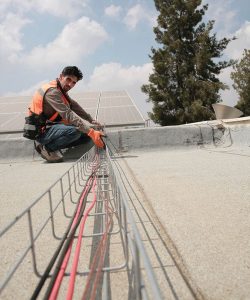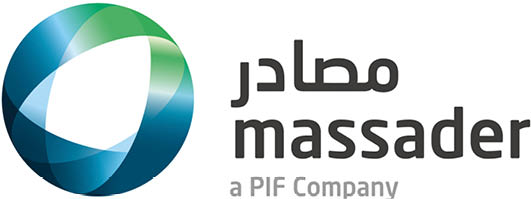Over the past decade, countries around the world have started to respond to the crisis of climate change through investing in renewable power. While many of these investments introduced innovative and affordable solutions diversifying energy mix, the political and economic realities have proved to be challenging for a similar rollout in Palestine. Despite the great potential of renewables in Palestine for energy diversification and security, that potential is not fully harnessed due to the external factors that constrain the Palestinian economy in general and more specifically its energy sector.

Scaling solar energy necessitates having large swaths of land. Equally important is the availability of an integrated electricity grid to evacuate the power generated, transmit it, and deliver it to demand centers. To date, Israel maintains direct full control over 61 percent*1 of the West Bank, known as Area C, which has the largest technical potential for solar energy in Palestine, with a capacity estimated at 3,000 megawatts (MW),*2 and constitutes more than 83 percentiii of the West Bank’s renewable energy potential. By comparison, the technical potential in areas A and B in the West Bank is significantly less and is estimated at 100 MW of distributed utility-scale solar plants.*4
This technical potential is further constrained due to scarcity of land and competing demands for other uses, such as urban, commercial, and agricultural development. Similarly, Gaza has no capacity for utility-scale plants due to land unavailability.*5 Accordingly, the ban on Palestinian development in Area C severely hinders the development potential of green energy and the opportunity for diversification, independence, and energy security in Palestine.
In addition to the inaccessibility to Area C for renewable energy development, there is no significant transmission infrastructure in Palestine. Israeli supplies of electricity to Palestinian towns and cities have been historically distributed on 270 medium-low voltage interconnection points, leading to fragmentation of the Palestinian network and significant technical losses. With Israel’s effective control over Area C and the high-voltage transmission network, Palestinian efforts to develop and upgrade the network into an integrated system able to unlock generation potential have been met with Israeli rejection.
Because of these circumstances, the energy sector in Palestine, like the Palestinian economy, has been characterized by an asymmetrical dependence on the Israeli economy. Palestine is heavily reliant on Israeli energy imports to meet over 95 percent*6 of its electric power needs with an annual bill of more than US$ 650 million for electricity.*7 This, in turn, has created a sharp trade deficit and exacerbated the Palestinian government’s fiscal deficit. The overdependency on the Israeli energy sector creates a vital need to introduce nationally generated energy at affordable rates to meet the growing energy demands in Palestine.

Despite the political, economic, and infrastructural challenges, investing in renewable energy presents a sensible and strategic opportunity for strengthening the Palestinian economy. Located in a region that is abundant with the sun’s irradiation, Palestine has high sunshine hours throughout the year, with the total annual average exceeding 3,000 sunshine hours and irradiation levels ranging between 5 and 6 kWh/m2 per day. Such conditions are considered excellent for harnessing solar energy in large-scale and stand-alone applications. Furthermore, the cost of solar is continually declining, as the cost of rooftop PVs and utility-scale solar have dropped more than 80 percent since 2010 – making it more attractive to potential investors.
Photovoltaics (PV) is a method of generating electrical power by converting solar radiation into direct current electricity using semiconductors that exhibit the photovoltaic effect.
Realizing the potential and strategic importance of expanding renewable energy in Palestine, significant efforts have been made to advance the sector through the following means.
1. Enactment of key legal and regulatory reforms: Based on the electricity law of 2009, followed by the renewable energy law in 2015, several new regulations and secondary legislations came into effect to regulate different schemes for renewable energy, both for commercial production and coverage of self-consumption of households and businesses under a net-metering scheme. On this basis, a new target of 130 MW of domestic renewable generation was set to be achieved by 2020. To reach such a target, the regulatory framework seeks to facilitate investment in renewable energy, as well as to incentivize consumer utilization of renewables.
2. The progress of sector expertise: The developments witnessed in renewable energy across local and regional markets have encouraged the rise of sector know-how experts and specialized companies in the field of renewable energy in Palestine.
3. The rise of Green-Energy Funds: Through an effort to promote green-energy investments in the Palestinian private sector, the French Development Agency (FDA) announced a contribution of $25 million to launch a green-finance fund through expanding its Sustainable Use of Natural Resources and Energy Finance (SUNREF) program in Palestine.
Massader: Investing in renewables to secure sustainable energy
To anchor the continuous development in the Palestinian energy sector, Massader – the Palestine Investment Fund’s arm in the energy and infrastructure sectors – is mobilizing a US$ 2 billion investment program to advance three key areas, including industrial infrastructure, digital infrastructure, and energy security through conventional and renewable energy.
Noor Palestine Solar Program (NPSP) is Massader’s leading project in renewable energy. With an investment portfolio of US$ 200 million and a total capacity of 200 MW, this program aims to provide scalable, inclusive, and innovative green-energy solutions and reduce the overdependency of imported electricity to ultimately strengthen the growth of the Palestinian economy.

Phase I of this program is already under implementation with a capacity of approximately 60 MW. This includes the following strategic projects.
• 3 Utility-Scale Solar Parks: With a total capacity of 21.5 MW spread in three geographic locations of the West Bank (Jericho, with a capacity of 7.5 MW; Tubas, with a capacity of 9 MW; and Jenin, with a capacity of 5 MW), a unique model has been developed for these parks whereby Massader, in close cooperation with the distribution companies, assumes all the risks associated with the development and construction of these parks through local and international expertise, and ensures their proper connection to the grid. Under the net-metering scheme, these plants are based on a model that clusters several large consumers to offset their energy consumption and create savings on their electricity bills targeting the industrial sector, the health sector, and the water and agriculture sectors.
• 500 Schools Solar Program: Through a collaborative partnership with the Ministry of Education and electricity distribution companies, and financing from international financing institutions such as the European Investment Bank and the International Finance Corporation of the World Bank Group, Massader is developing solar systems on 500 public schools in the West Bank and East Jerusalem, with a total capacity of 35 MW. In doing so, Massader seeks to achieve several goals at once: overcome the land-scarcity challenge that hampers rollout of solar-energy projects; introduce sustainable green energy to the schools; cover the electricity consumption of schools, thus creating savings on their electricity bills and freeing budgets that can be invested in the betterment of the education environment; generate excess energy that will be sold to the electricity distribution companies at competitive rates lower than the rates for import of electricity from Israel; and lastly, substitute for parts of electricity imports from Israel through a national power-generation project that meets the above objectives while also creating job opportunities and advancing the green-energy sector.
In parallel to the completion of phase I, Massader plans to develop additional medium solar parks and a large-scale solar park of 50 MW and above, as well as construct several strategic rooftop projects. Despite the harsh political and economic realities faced by the Palestinian energy sector, Massader believes that investing in renewable energy can spur innovative solutions and instruments towards energy diversification, reliability, affordability, and independence.
*1 World Bank 2018, 11.
*2 World Bank 2018, 9.
*3 World Bank 2018, 69.
*4 World Bank 2018, 10
*5 World Bank 2018, 10.
*6 World Bank 2018, 50.
*7 MAS 2015, 1.



